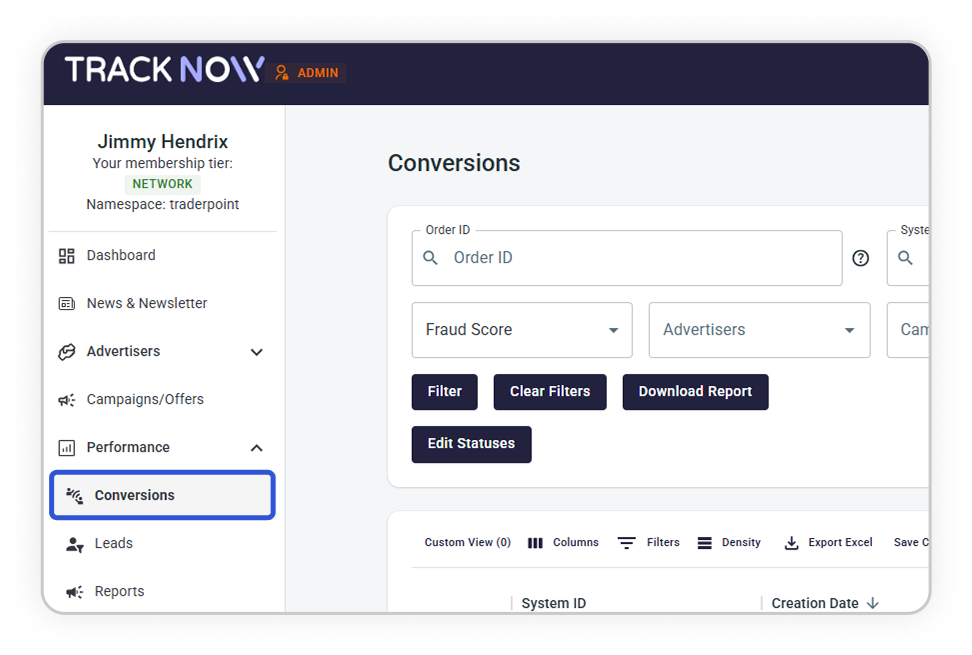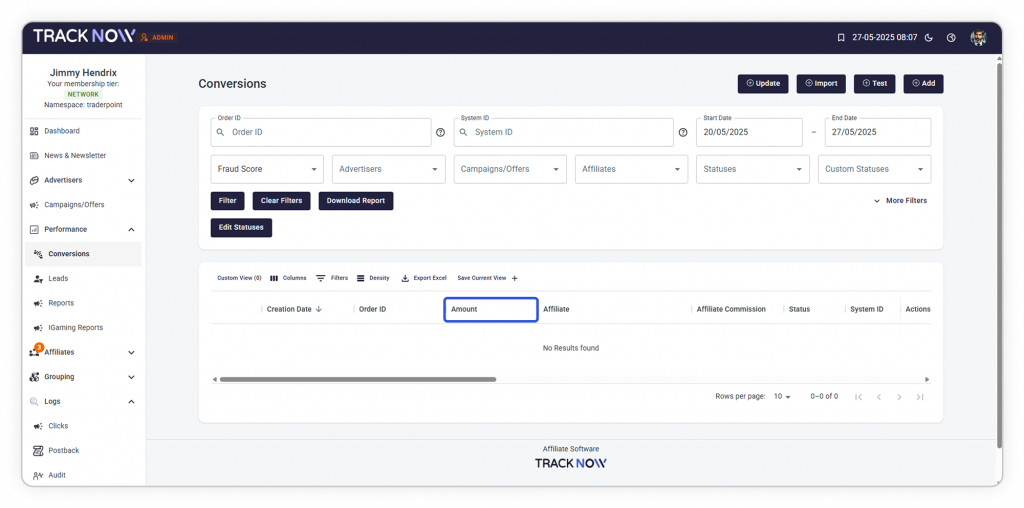To display any client action or event on your Tracknow dashboard, you need to send the details of that event to Tracknow. How you send these details depends on the type of integration you have with your website.
For example, if you’re tracking purchases, you might want to send information like the order ID, purchase amount, and client details.
In this article we’ll break down the available parameters Tracknow offers for each event.
Tracked Events
All events can be grouped into two main types, each type has its own dedicated screen – one for viewing leads and another for viewing conversions.
Leads
Any action a client takes on your website that doesn’t involve a payment but shows interest. For example, filling out a form or registering an account.

Conversions
Any action a client takes that involves spending money on your website, or any action for which you want to reward affiliates with a commission.

What each parameter represents?
Each event type has its own set of parameters that store specific details about the event.
These parameters appear as columns in the event records table for that event type.
For example, if you’re tracking purchases and you send the purchase amount using the amount parameter, the value will be shown in the Amount column on the Conversions table.

Supported Tracking Parameters
Below are the parameters you can use to send details about various events.
You can use only the parameters you need or want to see in Tracknow. However, some parameters may still be mandatory depending on the type of integration.
| Parameter Key | Corresponding Column | Description |
|---|---|---|
| campaign_id | Campagin/Offer | The Tracknow campaign ID that this purchase should be associated with. It is required in certain types of integrations |
| click_id | Click ID | A unique parameter that links the client or purchase to the referring affiliate. It is required in certain types of integrations |
| order_id | Order ID | The internal order ID from your webstore that identifies the specific order or purchase |
| amount | Amount | The amount paid by the client, which the affiliate commission can be based on |
| commission | no column | If you want the affiliate’s commission to be based on a specific value rather than the purchase amount, use this parameter to send that custom value |
| currency | no column | If purchases are made in different currencies, include the currency code in 3-letter ISO format (e.g., USD, EUR). This allows our system to convert the amount to your campaign’s default currency |
| conversion_rate | no column | You can provide your own conversion rate if you prefer not to use the system’s default rate |
| coupon | Coupon code | The coupon code entered by the client during the purchase |
| goal | no column | A unique parameter used to trigger a specific payout, based on a pre-configured goal value. Click here to learn more |
| comment | Comment | Add any comments or notes related to this purchase or order |
| ref_id | Affiliate | If you want to attribute this purchase to a specific affiliate, include their Tracknow Affiliate ID in this parameter |
| ref_custom_id | Affiliate | If you use custom Affiliate IDs, you can identify the affiliate using their custom ID instead of their ref_id |
| first_name | First Name | Client’s first name |
| last_name | Last Name | Client’s last name |
| Client’s email address | ||
| country | Country | Client’s country (ISO 3166-1 alpha-2 code format i.e UK, US, JP) |
| address | Address | Client’s address |
| postcode | Postcode | Client’s postcode |
| phone | Phone number | Client’s phone number |
| new_customer | no column | The value should be true or false, indicating whether the client is new. This helps establish a link between the client and the referring affiliate when using lifetime payouts |
| customer_id | no column | The value defined in your integration (such as a customer ID or email address) used to link the client to the referring affiliate when using lifetime payouts |
| skip_lifetime | no column | Send the value true if you want to create a lifetime link between the client and the affiliate, but prefer to pay the commission through a different payout instead of the lifetime payout |
| gaid | GAID | Google advertising ID |
| idfa | IDFA | A random device identifier assigned by Apple to a user’s iOS device |
| custom1 | custom1 | A parameter for any text or values you want to pass that don’t have a dedicated parameter |
| custom2 | custom2 | A parameter for any text or values you want to pass that don’t have a dedicated parameter |
| custom3 | custom3 | A parameter for any text or values you want to pass that don’t have a dedicated parameter |
| custom4 | custom4 | A parameter for any text or values you want to pass that don’t have a dedicated parameter |
| custom5 | custom5 | A parameter for any text or values you want to pass that don’t have a dedicated parameter |
| custom6 | custom6 | A parameter for any text or values you want to pass that don’t have a dedicated parameter |
| custom7 | custom7 | A parameter for any text or values you want to pass that don’t have a dedicated parameter |
| custom8 | custom8 | A parameter for any text or values you want to pass that don’t have a dedicated parameter |
| sub1 | sub1 | A parameter for any text or values you want to pass that don’t have a dedicated parameter. Affiliates can also use this parameter, but if you use it, your value will override theirs |
| sub2 | sub2 | A parameter for any text or values you want to pass that don’t have a dedicated parameter. Affiliates can also use this parameter, but if you use it, your value will override theirs |
| sub3 | sub3 | A parameter for any text or values you want to pass that don’t have a dedicated parameter. Affiliates can also use this parameter, but if you use it, your value will override theirs |
| sub4 | sub4 | A parameter for any text or values you want to pass that don’t have a dedicated parameter. Affiliates can also use this parameter, but if you use it, your value will override theirs |
| sub5 | sub5 | A parameter for any text or values you want to pass that don’t have a dedicated parameter. Affiliates can also use this parameter, but if you use it, your value will override theirs |
| sub6 | sub6 | A parameter for any text or values you want to pass that don’t have a dedicated parameter. Affiliates can also use this parameter, but if you use it, your value will override theirs |
| sub7 | sub7 | A parameter for any text or values you want to pass that don’t have a dedicated parameter. Affiliates can also use this parameter, but if you use it, your value will override theirs |
| sub8 | sub8 | A parameter for any text or values you want to pass that don’t have a dedicated parameter. Affiliates can also use this parameter, but if you use it, your value will override theirs |
Examples
These parameters can be passed using different Integration Methods, with the most common being postbacks and tracking pixels.
What these methods have in common is that they both involve generating a URL, appending the relevant parameters to it, and then calling that URL to send the data to Tracknow.
Here’s an example of a postback format that reports a purchase made by a client that was referred by an affiliate, the parameters we chose to pass in this example are the order ID, purchase amount, client’s first name and email address
https://exmaple-tracking.tracknow.info/postback?click_id={value}&campaign_id={value}&order_id={value}&amount={value}&first_name={value}&email={value}The actual purchase details should replace the {value} placeholders next to each parameter key. Once populated with real data, the final postback URL should look like this:
https://exmaple-tracking.tracknow.info/postback?click_id=a520dca8-ab08-4640-af65-034be3a68909&campaign_id=1&order_id=23315&amount=150&first_name=John&email=john.example%40gmail.com